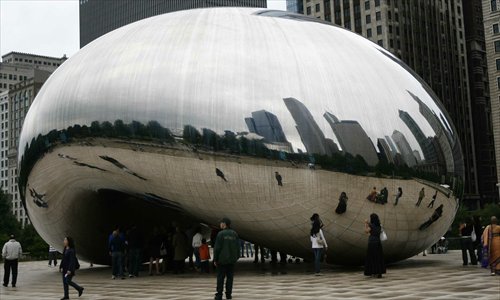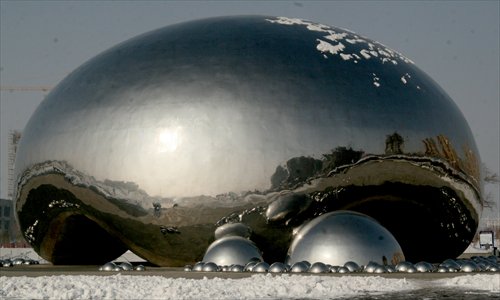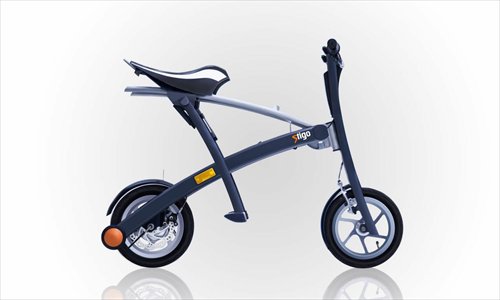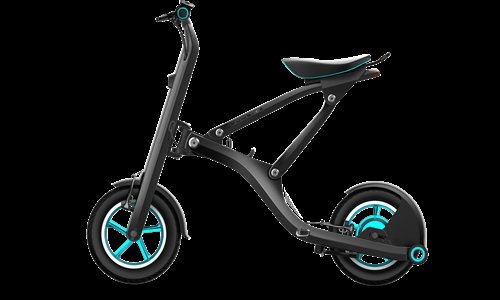Foreign nationals more confident in pressing IPR charges in China thanks to legal changes
Chinese companies have long been known as better mimics than innovators. But now foreigners are increasingly protecting their intellectual property, regularly taking firms to court over what they claim are copies. This trend may force Chinese companies to start taking risks in development rather than taking something that's been proven to work.

Cloud Gate, also known as The Bean, in Chicago. Photo: CFP

Sculpture known as Big Oil Bubbles in Karamay. Photo: Zhou Jianling
In early August last year, several photos of a giant "oil bubble," surrounded by dozens of smaller hemispheres, all made of shiny stainless steel, were widely circulated on the Internet.
The bubbles are part of a new sculpture in Karamay, an oil-boom city in the Gobi desert, Northwest China's Xinjiang Uyghur Autonomous Region. Under the biggest bubble, the centerpiece of the sculpture, lies the disused wellhead of the Karamay No.1 Well, which started to spew oil in October 1955, marking the birth of the Karamay Oil Field, China's first major oil field.
This sculpture was soon slammed as a knockoff by British sculptor Anish Kapoor, who pointed out similarities between the Karamay piece and his famous 2006 Cloud Gate sculpture, also known as The Bean, which stands in Millennium Park, Chicago.
In a statement on August 12, Kapoor said he would sue those responsible for the Karamay sculpture. "The Chinese authorities must act to stop this kind of infringement and allow the full enforcement of copyright," he was quoted as saying by Britain's The Telegraph daily.
"We have a legal team consisting of Chinese and American lawyers," Kapoor recently told the Global Times.
Estonian designer Matti Ounapuu has also found his work has "inspired" a Chinese company. In October last year, he accused tech company Yunzao of plagiarizing his Stigo folding electric scooter.
On October 15, Yunzao, based in Hangzhou, East China's Zhejiang Province debuted two products, including the 4,999 yuan ($765) Yunma X1 folding electric scooter. Ounapuu pointed out that the Yunma X1 resembles the Stigo, and claimed several design features he developed for his scooter have been copied.
When he didn't receive an apology, Ounapuu decided to take legal action. "I'm sad because it was presented as Yunzao's original design where in fact it was not original but based on my design. Copying is one thing but claiming originality of authorship is another," the septuagenarian told the Global Times.
He started a Weibo account with the help of a Chinese friend and expressed his rage over Yunzao's "infringement" in words and video, which received thousands of likes.
On November 17, he posted a stamped legal letter, showing that he and Stigo Co., Ltd, an Estonian tech company, had entrusted Unitalen Law Office, a major Chinese law firm keen on intellectual property rights (IPR) cases, to seek justice.
Wu Shuchen, the partner and a patent attorney at the firm who is in charge of the case, revealed to the Global Times that they are now collecting evidence.
With 16 years of IPR experience, Wu says he thinks that international IPR cases such as Ounapuu's and Kapoor's will likely grow more common and domestic firms will find they have to become more honest.
"As the public awareness of IPR grows and the legal system to protect IPR improves in China, foreign nationals have more confidence in resolving IPR disputes," Wu explained.

A Stigo folding electric scooter. Photo: Courtesy of Lingling Tech

A model of Yunma X1 by Yunzao Technology. Photo: yunzao.cn
'Similar from some angles'
In both cases mentioned above, the Chinese companies have denied plagiarizing their designs.
"We are confident and have adequate evidence to prove our design is not plagiarized," Yang Xu, lead designer of the Karamay "oil bubbles" and teacher at an art college in Chengdu, Southwest China's Sichuan Province, told the Global Times last week in his first public response to the accusations.
"I don't worry about lawsuits. In contrast I am convinced that the judicial proceedings can clear our names," he noted.
According to the 33-year-old sculptor who was born in Xinjiang, his design won the bid from the Karamay government in 2013.
"Before that I had spent a year in the city, researching its unique elements for the design," Yang said. He says that old pictures of oil bubbles from an oil spill, a scene unique to the city, inspired him.
The sculpture was finally completed in October last year. It is made up of a main "bubble," which is 15 meters tall and 28 meters in diameter, and 200 smaller spheres.
Yang admitted that the central bubble looks like The Bean from some angles, but argued that the similarities are hard to avoid when making bulbous sculptures with stainless steel.
"In addition, resembling a turtle shell, mine has four supporting points touching the ground and four doorways leading to the center below the bubble, different from The Bean," Yang said. The Bean has two points touching the ground.
Nevertheless, Kapoor didn't buy the explanation. "I cannot agree. This is blatant plagiarism and I will have to sue it," he insisted.
Yunzao also insisted that they are innocent. "We have seen the picture of Stigo and been impressed by its design, but we haven't plagiarized," said Yunzao's CEO Qiu Yiwu.
In a statement on October 28, Qiu said they had acquired several patents for the Yunma X1, including patents in the EU.
However, He Yizhou, co-founder of Lingling Tech, a Chinese firm which cooperates with Stigo Co., Ltd and takes charge of Stigo's production and sales, argued that Ounapuu had already filed patents in China and Europe.
"We are going to apply to the Patent Reexamination Board of the SIPO (State Intellectual Property Office) and ask for the invalidation of Yunzao's patent rights in China," He told the Global Times. Their attorney Wu Shuchen noted that patents should be invalidated if their key components or design features copy an earlier patent.
Qiu said they welcome Ounapuu's legal challenge and have decided to suspend the sales of the X1 until the dispute is resolved.
He Yizhou saw this suspension as a success following Ounapuu's complaint. He revealed that they will mass produce the Stigo in China in April through two Taiwan-funded factories.
'Manufacturer rather than creator'
These two disputes are only a tiny part of the picture. Official statistics by the Supreme People's Court show that Chinese courts dealt with 94,501 IPR-related trials in 2014. This included 1,716 cases that involved overseas parties, a growth of 25 percent since 2010.
Kapoor told the Global Times he usually pursues legal solutions for plagiarism. "It happens that works are copied from time to time. We always pursue plagiarism and seek compensation," he said.
Benjamin Bai, head of British law firm Allen & Overy's Shanghai IPR department, believes that there are still barriers obstructing foreign plaintiffs.
"One is their poor knowledge of the Chinese litigation system which is different from that in many countries. Another is that some don't think that they can get a fair result. Yet another issue is that the courts in China need to improve," Bai told the Global Times.
Wu claims such worries are unnecessary. "When the case is foreign-related and involves international enterprises, the courts will attach more importance to it and arrange higher-level judges," he argued. "There's little possibility for unfair judgment, which would affect the national image."
In addition, foreign companies, especially larger ones, usually invest a lot in IPR protection and maintenance, and their patent filings are usually complete, stable and strong, Wu said.
Over the past decades, Chinese companies have repeatedly been hit with IPR infringement complaints. But only in recent years has the government been working to enhance IPR protection.
In November and December 2014, China established IPR courts in Beijing, Guangzhou and Shanghai. In last April, the Supreme People's Court, the country's highest, invited diplomats and delegates from several embassies and consulates to observe an IPR case in Beijing.
According to a recent report by the Beijing Daily, the IPR office and education bureau in Beijing Municipality have jointly compiled textbooks on IPR and plan to hold IPR lessons in primary and middle schools in the city this autumn.
In addition, Chinese legislators are revising the Patent Law, with the new version expected to impose heavier penalties on violators.
Sun Yi, a co-founder of Lingling Tech, lamented that despite these efforts, China's IPR reputation is still poor. He shared an experience he had at the Consumer Electronics Showroom in the US in January.
"Different from the warm welcome they showed to other visitors, the foreign exhibitors were apparently unhappy to see our arrival at their booths," Sun told the Global Times.
"It seemed that they were on high alert for the Chinese and feared we would copy their inventions just by looking. Such treatment is frustrating," he noted.
Chinese companies are good at imitation but less good at originality, which requires more investment and is riskier, Sun said. "This relates to the environment. Despite accusations, many investors continue to support suspected IPR infringers."
But in recent years, the public has become more aware of IPR protection and less tolerant of dishonesty. In May last year Shanghai's Fudan University made an apology and removed a celebratory video for its 110th anniversary after it was publicly accused of copying a 2014 video from the University of Tokyo.
But in an article published on kuaizhihui.com, an online platform that assists people in getting patents, Deng Yingshan, former patent engineer with multinational manufacturer Foxconn, said "micro-innovation" should be praised.
"Any technological progress is based on the shoulders of giants. We shouldn't use plagiarism to find fault with micro-innovation, but should give it more space and tolerance."
Yang Xu felt wronged when the Karamay government downplayed his sculpture and stopped him from publicly refuting Kapoor's accusations last year, especially when many Chinese netizens joined the chorus of criticism.
"Some Chinese are biased or stereotype that we ourselves are not able to create," he said.
Ounapuu however said that plagiarism should be rejected in all forms. "If all the good designers turn to copying then China will lose its competitiveness. China will always be a manufacturer rather than creator," he said.
Gao Lei contributed to this story
Newspaper headline: Design defenders